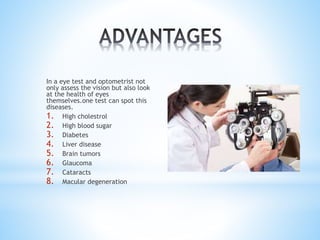High-grade Retina Service Near Me: Leading Eye Care Providers
High-grade Retina Service Near Me: Leading Eye Care Providers
Blog Article
The Duty of Advanced Diagnostic Devices in Identifying Eye Disorders
In the realm of ophthalmology, the application of sophisticated diagnostic tools has actually reinvented the early recognition and administration of numerous eye conditions. From detecting subtle modifications in the optic nerve to keeping track of the progression of retinal diseases, these modern technologies play a critical function in enhancing the precision and performance of identifying eye problems. As the need for exact and timely medical diagnoses continues to expand, the combination of innovative devices like optical coherence tomography and visual area screening has ended up being important in the world of eye treatment. The intricate interaction in between modern technology and sensory practices not just loses light on elaborate pathologies however additionally opens doors to tailored therapy techniques.
Relevance of Very Early Diagnosis
Very early medical diagnosis plays a pivotal role in the efficient management and treatment of eye conditions. Prompt recognition of eye problems is crucial as it allows for prompt treatment, potentially stopping further development of the illness and reducing long-term problems. By detecting eye conditions at a beginning, doctor can offer appropriate therapy plans tailored to the particular condition, inevitably resulting in far better results for people. Moreover, very early diagnosis enables individuals to gain access to required assistance solutions and sources sooner, boosting their general lifestyle.

Technology for Detecting Glaucoma
Cutting-edge diagnostic modern technologies play a vital duty in the very early discovery and monitoring of glaucoma, a leading root cause of permanent blindness worldwide. One such technology is optical coherence tomography (OCT), which provides comprehensive cross-sectional pictures of the retina, permitting the measurement of retinal nerve fiber layer thickness. This measurement is essential in examining damage created by glaucoma. Another sophisticated tool is visual field testing, which maps the sensitivity of a client's aesthetic area, assisting to detect any kind of locations of vision loss characteristic of glaucoma. Furthermore, tonometry is used to determine intraocular pressure, a significant threat aspect for glaucoma. This examination is vital as elevated intraocular pressure can lead to optic nerve damage. Newer technologies like the usage of synthetic intelligence algorithms in analyzing imaging data are showing appealing results in the early detection of glaucoma. These advanced diagnostic tools enable eye doctors to identify glaucoma in its very early phases, enabling timely intervention and much better monitoring of the disease to stop vision loss.
Function of Optical Coherence Tomography

OCT's capacity to quantify retinal nerve fiber layer density enables for site specific and objective dimensions, helping in the early detection of glaucoma also before visual area defects come to be evident. On the whole, OCT plays a vital duty in improving the analysis precision and administration of glaucoma, inevitably contributing to far better results for individuals at risk of vision loss.
Enhancing Medical Diagnosis With Visual Area Testing
A vital component in extensive ophthalmic evaluations, visual area testing plays a critical role in improving the analysis process for various eye conditions. By examining the full degree of a client's aesthetic field, this test gives essential info regarding the practical stability of the entire aesthetic pathway, from the retina to the visual cortex.
Aesthetic field screening is especially useful in the medical diagnosis and administration of conditions such as glaucoma, optic nerve disorders, and different neurological conditions that can impact vision. With quantitative measurements of outer and central vision, medical professionals can detect refined changes that might indicate the existence or development of these conditions, even prior to noticeable signs and symptoms occur.
In addition, visual field screening enables the tracking of treatment efficacy, helping eye doctors tailor restorative treatments to individual clients. eyecare near me. read what he said By tracking adjustments in visual field efficiency gradually, doctor can make informed choices concerning changing medicines, recommending surgical interventions, or carrying out other appropriate procedures to maintain or boost an individual's visual feature
Taking Care Of Macular Degeneration

Conclusion
In verdict, progressed diagnostic tools play an essential role in recognizing eye conditions early on. Technologies such as Optical Coherence Tomography and aesthetic field screening have substantially enhanced the precision and performance of detecting problems like glaucoma and macular deterioration.
Report this page